As the pace of modern life accelerates, an increasing number of individuals are turning to super-automatic espresso machines as their personal at-home baristas. This trend has seen a surge in brands entering the market with an array of futuristic coffee marvels. Jura, in my opinion, sits comfortably on the throne in this kingdom of coffee gadgets. But if their price tags startle you, there are more budget-friendly contenders worth considering, such as the Gaggia Anima Prestige or the Saeco Picobaristo.
If you’re in the market for an uncomplicated, budget-friendly “press and go” espresso machine, the Saeco Picobaristo should definitely be on your shortlist. While it may lack a futuristic interface, state-of-the-art technologies, and a long list of pre-set drink options, it can still deliver delectable espressos daily, making it an ideal companion for a household of one or two.
The Gaggia Anima Prestige, on the other hand, is essentially the same as the winner in most respects, except it has fewer grind settings and pre-set drinks. Naturally, it also comes at a more affordable price, affirming the adage, “You get what you pay for.”
Gaggia Anima Prestige Vs Saeco Picobaristo: Comparison Chart


Last update on 2025-04-14 / Affiliate links / Images from Amazon Product Advertising API
Gaggia Anima Prestige Vs Saeco Picobaristo: Differences
The Saeco Picobaristo knocks out the Gaggia Anima Prestige with a score of 4-2. Let’s scroll down and read to the end to avoid missing valuable information.
Coffee Flavour
Winner: Saeco Picobaristo
Built-in Grinder
Both machines feature a ceramic flat burr grinder, which is truly a boon for coffee aficionados. You don’t need to be a rocket scientist to understand that ceramic materials don’t conduct heat as well as steel. And why is this significant? Well, it means that a ceramic grinder won’t overheat like its stainless steel peers, preserving the delicate aroma of the coffee beans. This is crucial, as heat can compromise the beans’ aromatic integrity, leading to subpar espressos.
Moreover, ceramic grinders are famed for their longevity. It’s a whisper among coffee connoisseurs that they can produce an astounding 20,000 cups of coffee. Naturally, this claim remains shrouded in mystery, so its veracity may be elusive. But what I do know for sure is that they operate very quietly – about 62-64 dB (which is comparable to the volume of an average conversation or the hum of an air conditioner). So you can start your new day’s brewing cycle early in the morning without waking your whole family.
Next, I’ll shift the spotlight to another vital facet: the array of grind settings. For a super-automatic coffee machine, I personally favor a wide spectrum of settings, allowing me to play around more freely to tailor the fineness and coarseness of the beans to my heart’s content.
The Gaggia Anima Prestige has only 5 different settings of grind, which is not much but acceptable for its pocket-friendly price. As for the Saeco Picobaristo, it blew my mind with 10 settings!!? I’ve tried, such as the Jura Z6, which comes with a hefty three-grand price tag but doesn’t boast as many grind settings. Hats off to Saeco Picobaristo!
Adjusting the grind settings on the Gaggia Anima Prestige proved to be somewhat of a puzzle. Specifically, I had to align a dosing spoon with a yellow tip situated in the bean hopper and then engage in a bit of pressing and twisting. Why didn’t Gaggia just add a knob to make things simpler? Who knows?
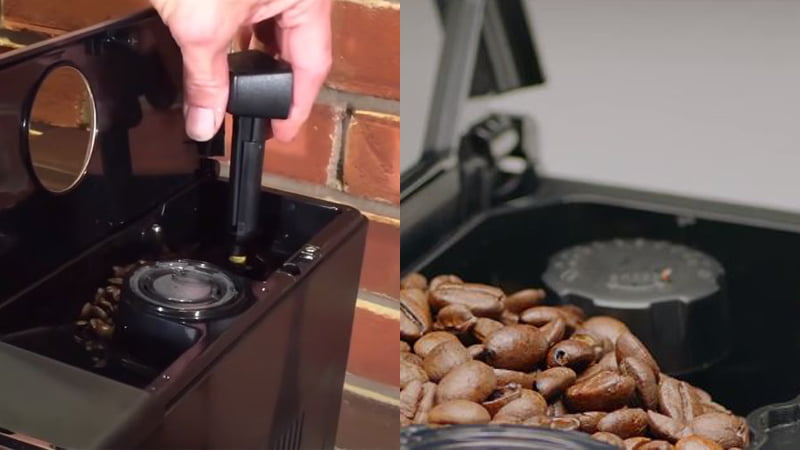
Heating System
If your household is filled with individuals who kick start their day with a frothy, milk-based beverage, or if you’re seeking a machine for a larger group setting, I suggest exploring beyond these models. Given their single boiler system, they fall short in their ability to simultaneously steam milk and brew coffee – only models with double boilers like the Jura Giga 6 can do this.
But the silver lining here is that you don’t have to wait too long to get your favorite drink. Their boilers are made of aluminum and lined with stainless steel, which significantly cuts down on heat-up and wait times. So you’ll find yourself brewing from cup to cup with minimal delay. Of course, this is only fine when you don’t have to prepare large batches of drinks.
Brewing System
What these “bean-to-cup” machines have in common is that they can make espressos with minimal human involvement. Just ensure their water reservoirs and bean hoppers are filled, choose your preferred drink, make the necessary customizations, wait, and presto. Of course, you pay for them, so you don’t have to become a skilled barista, right?
In addition, before the extraction process takes place, the coffee grounds undergo a process called “pre-infusion.” True to its name, the system dampens the grounds with a precise quantity of hot water to secure an optimal extraction, resulting in an exquisitely balanced espresso.
They also share a programmable dispensing system. Simply put, you can customize their one-touch drinks to five brew strengths and three brewing temperatures, as well as drink sizes. It takes some time and effort to find a combination that suits your taste, but once determined, it can be saved for easy one-touch access in the future.
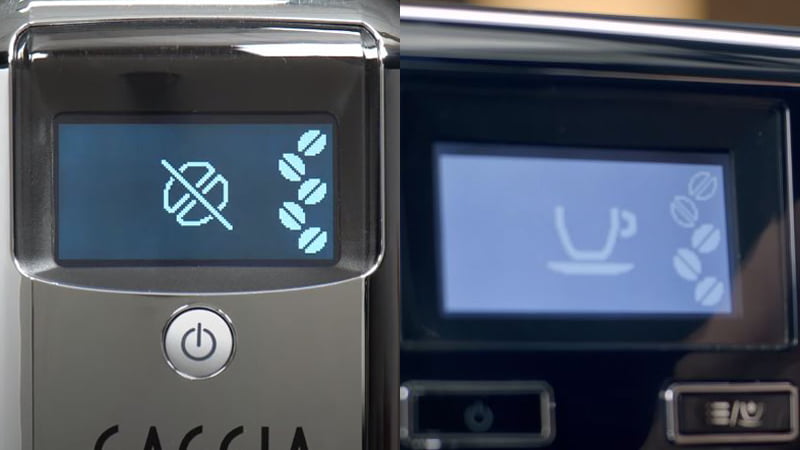
I’d like to say the espressos brewed by these machines stand head and shoulders above their peers in the same price range. It might require a smidgeon of trial and error before you unearth the blend that’s a bullseye for your taste buds. I don’t know about your taste, but personally, I lean towards a robust espresso with the finest grind and maximum strength – the sort that can send shivers down your spine!
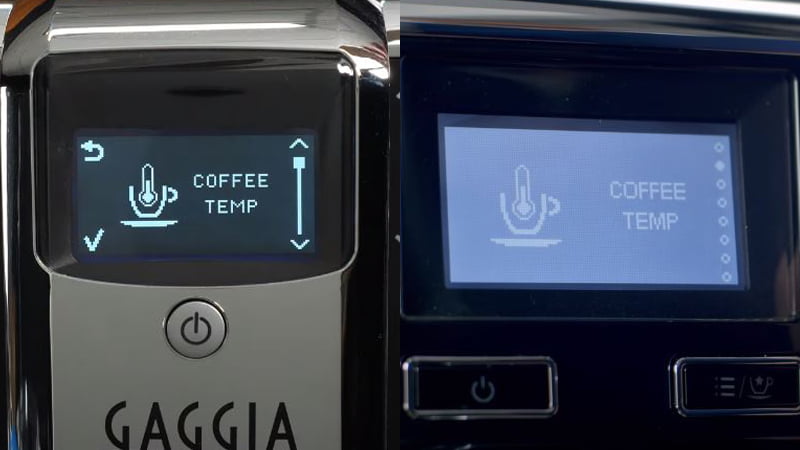
Milk System
In contrast to certain super-automatics like the Gaggia Velasca, which features an integrated steam wand and a bit of a learning curve, both these models come equipped with an automatic milk frothing system. This makes them a great option for novices since they wholly automate the milk frothing process.
Your role in this couldn’t be simpler: fill the milk jug, replace the water spout with it, open up the milk dispensing spout, pick your favorite milk-based drink, and enjoy your favorite foamy drink! Everything is so easy that I thought a child could brew drinks that match the standards of a seasoned barista. Sure, it’s a bit of an overstatement, but I just want to highlight these machines’ ease of use.
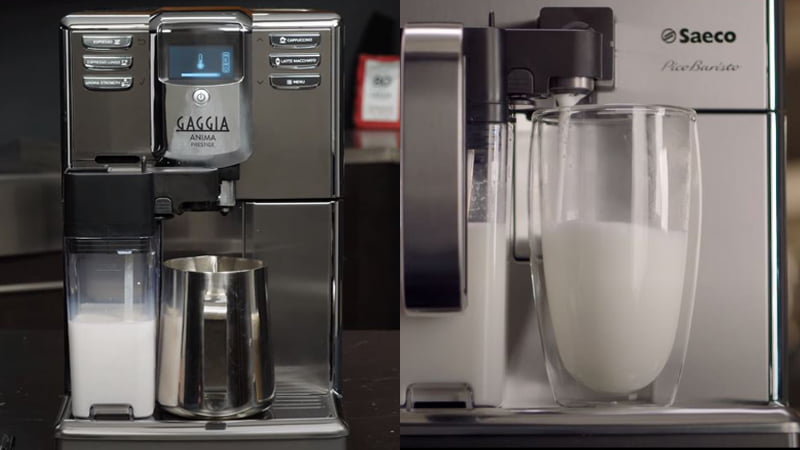
Once the milk froth is done, rinsing the spout is also a breeze with the push of a button, and hot water will go through the circuit after a few seconds. You don’t want those milk residues affecting the taste of your milk-based drinks.
In addition, I would also like to commend the neatness and compactness of their milking system. There’s no pesky tube here – there’s just one milk carafe neatly organized in front of the machine, which saves a lot of counter space. The carafe can also be refrigerated to ensure milk stays fresh when not in use – I wholeheartedly recommend utilizing any leftover milk within three days.
My only gripe is that it is required to remove the hot water dispenser to attach the milk container. This was not a big deal for me, but it can be frustrating for some people. Anyway, you always have to take the bad with the good.
Design & Usability
Winner: Saeco Picobaristo
Dimensions, Footprint, & Weight
| Gaggia Anima Prestige | Saeco Picobaristo | |
|---|---|---|
| Dimensions | 8.7 x 13.4 x 17.0 inches | 8.7 x 13.2 x 17.2 inches |
| Weight | 19.1 lbs | 22.04 lbs |
These machines come adorned with a nostalgic 90s aesthetic, equipped with a pixelated monitor and some antiquated buttons – something typical for super-automatic coffee machines under $1,000. They look more like an old-fashioned PC with coffee-making functions than an espresso machine. Therefore, if you’re anticipating something more contemporary, with touchscreens and perplexing buttons, you might find these machines a bit of a letdown.
These machines primarily employ cost-effective ABS plastic in their construction to maintain low production costs. However, the stainless steel fronts give them a reassuring, robust appearance, as though they’re built to last for ages. Naturally, it’s still too early to comment definitively on their durability, so I’m keeping my fingers crossed that they can brew tens of thousands of espresso cups during their operational lifetime.
These espresso machines are compact, especially in width, so they take up little counter space, meaning they occupy minimal counter space. It’s a rare treat to discover such a compact espresso machine, so finding a dedicated spot for them is as easy as pie. Moreover, the neatly positioned milk carafe in the front also contributes to their minimal footprint. So anyone with a small kitchen will undoubtedly appreciate them.
However, they are heavier than they seem, probably largely due to the stainless steel material used. Hence, carefully contemplate the positioning of your machine to ensure infrequent movement in the future.
Pre-programmed Coffee Options
| Gaggia Anima Prestige | Saeco Picobaristo |
|---|---|
| Espresso Espresso Lungo Cappuccino Latte Macchiato Milk Froth Hot Water | Espresso Espresso Lungo Cappuccino Latte macchiato Ristretto Caffe crema Double espresso Cappuccino Baby cappuccino Flat white Milk froth Hot water |
The Gaggia Anima Prestige, offering four coffee specialties, makes it a suitable choice for a one- or two-person family. Meanwhile, the Saeco Picobaristo, with a broader array of preset beverages, can meet the coffee desires of each member in a larger household. And for settings like an office environment, a machine that offers a more extensive drink selection and, of course, carries a higher price tag, such as the Jura Z10, would be required.
These machines allow you to tweak pre-programmed drinks in terms of coffee strength, brewing temperature, shot length, and so on. This implies that there’s a potential treasure trove of drink variations that can be concocted, but only a few suit you best. When you find them, save them, and they will become one-touch for feature use.
These machines also have a hot water option. I initially considered it a superfluous addition to ridiculously lengthening the machine’s list of specialties, but in hindsight, I had to admit it was really helpful. This option becomes a lifesaver whenever your espresso feels bitter or over-extracted: just add some hot water to dilute it, and you have a perfectly palatable Americano. Plus, it’s handy for those times when you fancy a cup of tea or yearn for a bowl of ramen. Essentially, it can take the place of your conventional kettle.
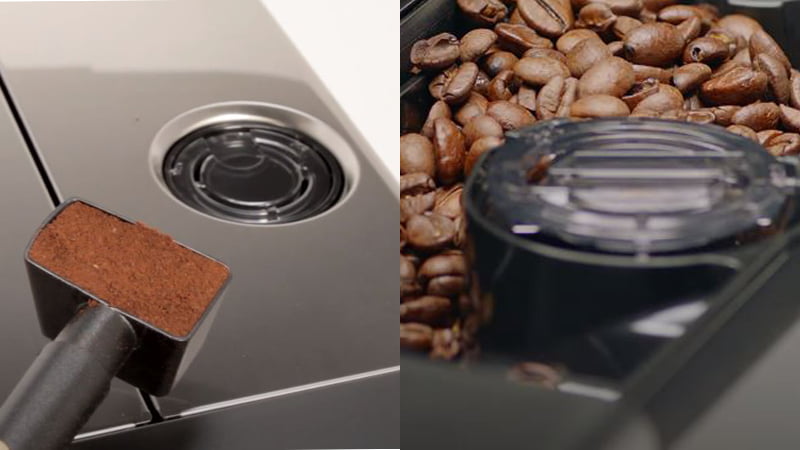
Spout & Cup Clearance
| Gaggia Anima Prestige | Saeco Picobaristo | |
|---|---|---|
| Spout Type | Dual | Dual |
| Cup Clearance | 4.3 – 6.5 inches | 3.0 -6.5 inches |
Their dual coffee spigots can lift up to 6.5 inches, allowing them to fit all my cups, including my latte glass and travel mug. The Saeco Picobaristo even takes it a step further by having a removable spout, making it compatible with somewhat taller cups. This is great, but I wish their coffee dispensers could be lowered a bit to preserve the lovely crema on top of the espresso cup and avoid irritating splashes that call for extra cleaning.
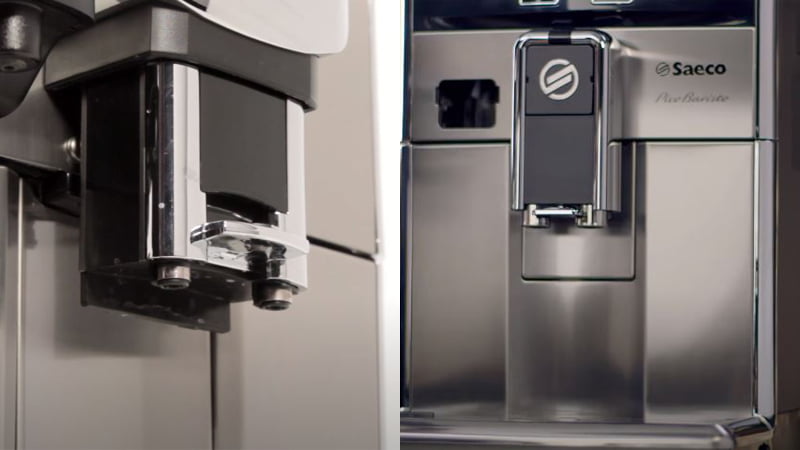
Water Reservoir & Bean Hopper
| Gaggia Anima Prestige | Saeco Picobaristo | |
|---|---|---|
| Water Reservoir | 1.8 liter | 1.77 liter |
| Bean Hopper | 0.26 liter | 0.26 liter |
Their water compartments are generally more than enough to satisfy caffeine needs at home without needing to be refilled too often. Regardless of whether the tank is emptied by day’s end, I advise draining and replenishing it with fresh water for the optimal espresso experience.
“Water hardness” might be a phrase you’ve come across, denoting the volume of minerals such as calcium and magnesium, among others, in water. But why is this of any interest to an espresso machine user? The explanation is straightforward. When water is heated inside the machine via the boiler, these minerals transform into solids, creating a build-up referred to as “scale.” This not only taints the quality of the espresso but can also spell potential disaster for the machine itself.
There’s good news for coffee enthusiasts: brands like Gaggia, Saeco, and many others have preemptively tackled this issue. They’ve engineered their machines to accommodate filters in their water tanks. You’ll find an AquaClean filter in the package with the Saeco Picobaristo, while the Gaggia Anima Prestige is designed to be used with an Intenza Water filter cartridge, which, however, is an additional purchase.
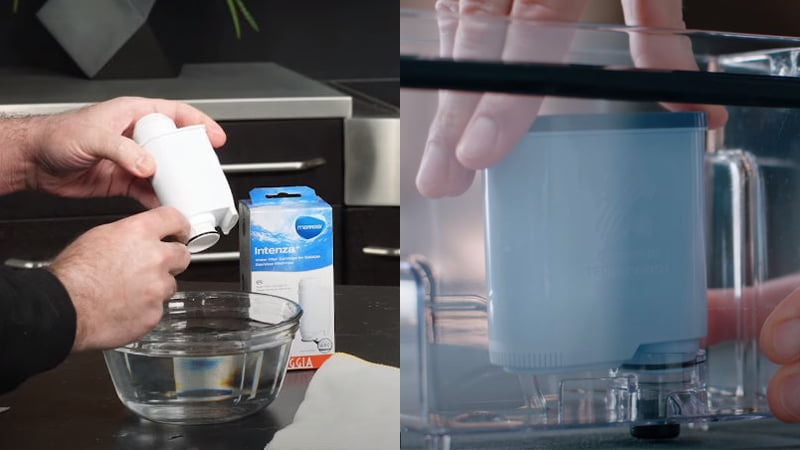
These filters are designed to remove these minerals, so you will rarely find yourself having to descale your machine. Using the filter will result in a recurring cost associated with its replacement. But believe me, fellow! It is worth it, considering the great benefits it brings to the table! You can accept or decline this filter
Their 0.26-liter bean hoppers can hold up to 250 coffee beans. However, there is a potential downside—the top lids are not completely airtight. As a result, the beans run the risk of exposure to air, which can hasten the loss of freshness, potentially leading to subpar espresso quality.
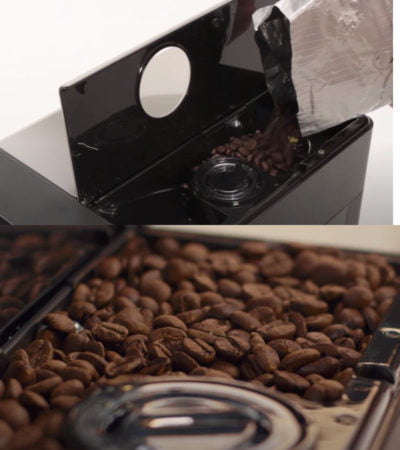
Cleaning & Maintenance
Winner: Tie
I wouldn’t say cleaning and descaling these models isn’t a waste of time, but it’s not a troublesome experience at all. The machine’s LED screen is there to give you a friendly nudge when maintenance is necessary, and then it will walk you through all the steps needed to get the job done.
When it comes to descaling these machines, make sure you use the appropriate descaling solutions: Gaggia Descaling solution for Gaggia Anima Prestige and Philips Decalcifier for Saeco Picobaristo. Even though there’s an abundance of cheap descaling solutions out there, it’s wise to dodge them, but it’s best to avoid them unless you want to kiss your espresso machine goodbye soon. The machine will take care of most of this process, and it will tell you what to do.
The cleansing of the milk system is a fully automated process, requiring just a simple push of a button after each use and a burst of hot steam will help maintain the hygiene of the system. However, it doesn’t replace the necessity of thorough hand washing, and the built-in carafe itself is dishwasher safe.
Moreover, the brewing groups in these machines are detachable, necessitating manual cleaning. While this may initially seem inconvenient and time-consuming, it’s actually an excellent strategy for preserving their longevity. A host of high-end super-automatic models like the Jura series come with built-in brewing groups. While these may offer the convenience of automated cleaning cycles, they often require costly cleaning solutions. This may keep your hands clean, but I wager that the brew groups which are manually cleaned will invariably outlast their counterparts. Just remember that a towel should not be used to wipe the brew group since there is a possibility of leaving fabric fibers that can damage the machine.
Finally, don’t overlook the small but important daily tasks, such as emptying the drip tray, discarding used coffee grounds, replenishing the water tank, and more. All your machine asks for is little loving care, and in return, it will treat you to an unending stream of delectable espresso. Sounds like a delightful deal, doesn’t it?
Utilities & Other Features
Winner: Tie
User Interface
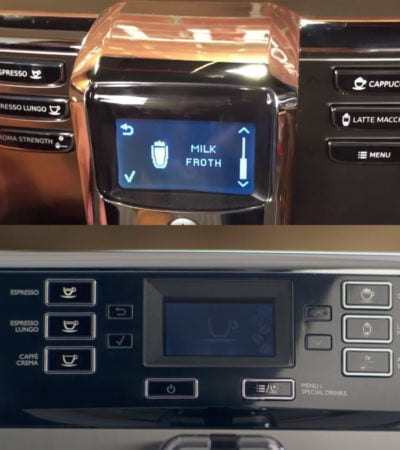
Did I tell you that their screens look old-fashioned? I’m merely teasing, not lodging any criticisms here! In fact, I found their user interface to be very intuitive, and the physical buttons made navigation easier than touchscreens. Choosing a pre-programmed beverage is easy by pressing a button labeled with its name, and you can also activate the “StandBy” mode so that the machine consumes less power and lowers your monthly electricity bill.
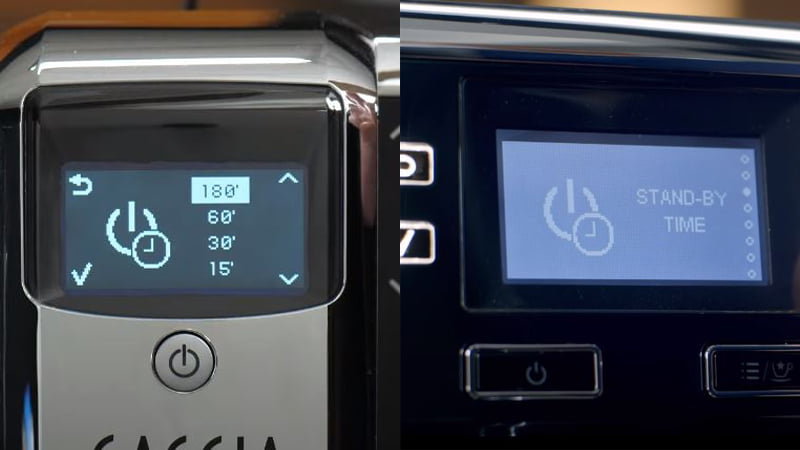
Quick Rundown Of Saeco Picobaristo
- Note: 1)Too coarse a grind, too little coffee, or insufficiently tamping the grounds before brewing can all lead to inadequate pressure for a proper brew. 2)It is important to note that the amount of espresso extracted will vary depending on the grind size and amount and reprogramming may be needed when the size and amount are adjusted
- Easily select one of 15 delicious drinks, or customize it to your taste with coffee equalizer and save it to one of 6 user profile
- Our Patented AquaClean water filter eliminates the need to descale for up to 5,000 cups
- Get superior taste for 20,000 cups with our durable ceramic grinders
- The hygiesteam function cleans the whole Milk circuit with steam, from the spout to the milk tubes
Last update on 2025-04-14 / Affiliate links / Images from Amazon Product Advertising API
Quick Rundown Of Gaggia Anima Prestige
No products found.
Product Videos
Related Articles to Saeco Picobaristo
- Saeco Picobaristo vs Xelsis: Ultimate Guide To Choosing #1 Espresso Machine For You
- Saeco Picobaristo Vs Jura D6: Selecting Your Perfect Brew Buddy!
- Saeco Incanto vs Saeco Picobaristo: Honest Review With Complete Comparison
- Saeco Picobaristo Vs Philips 3200: A Detailed Face-Off Comparison
- Gaggia Cadorna Prestige vs Saeco Picobaristo: 2 Most Worthy/Affordable Machines I Test This Year!
Related Articles to Gaggia Anima Prestige
- Jura D6 vs Gaggia Anima Prestige: The Way Of Espresso – Which One Should You Choose?
- Gaggia Anima Prestige vs Saeco Incanto: 2 Akin Models – Which Performs More Smoothly?
- Gaggia Anima Prestige vs Accademia: Which Espresso Machine Is Worth The Investment?
- Gaggia Anima Prestige Vs Babila: Which One Is Your Best Bet?
- Gaggia Anima vs Anima Prestige: Is Anima Prestige More Innovative Than The Standard Anima?
- Gaggia Anima Prestige Vs Velasca Prestige: A Head-To-Head Comparison
- Gaggia Cadorna Prestige vs Anima Prestige: Which Of These Gaggia’s Espresso Makers Brews Better?
- Gaggia Anima Prestige Vs Philips 3200 LatteGo: A Head-To-Head Comparison
- Gaggia Anima Prestige Vs Breville Barista Touch: In-Depth Review and Detailed Comparison
References:
- Gaggia Anima Prestige: https://www.gaggia.com/automatic-machines/anima-prestige/
- Saeco Picobaristo: https://saeco.com/picobaristo/

I’m Floyd J. Alcock, an experienced barista with a deep love for coffee. I curate personalized coffee experiences, guiding customers through diverse flavor profiles and suggesting ideal brewing methods. My extensive knowledge of espresso machines enables me to recommend the best equipment to match specific needs and budgets. Sharing my expertise and passion with coffee enthusiasts brings immense satisfaction. I look forward to continuing my journey of coffee discovery with every customer I serve, fostering connections over a shared love for this magical beverage.
